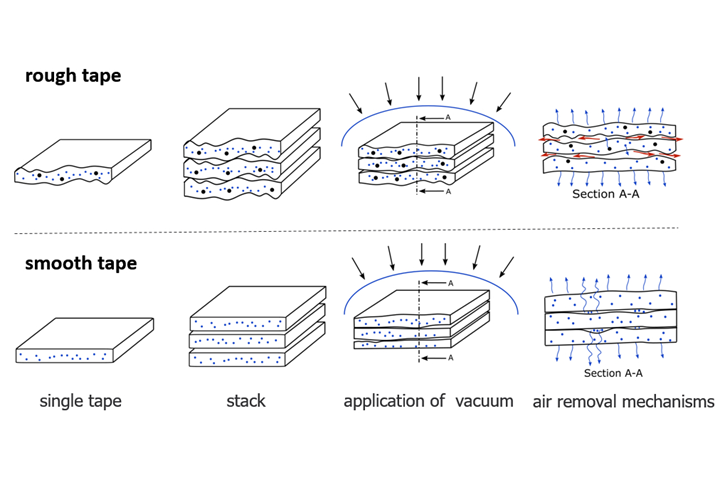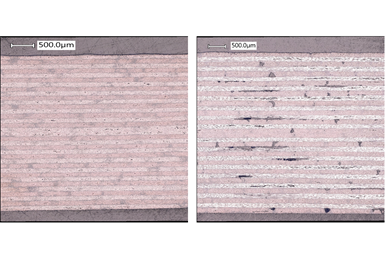TPRC investigates AFP in-situ consolidation alternative
The two-step process involves deposition of thermoplastic prepreg via AFP, followed by vacuum-bag-only (VBO). Research has already been completed in the qualitative stage.

Figure 1. Different air removal mechanisms such as in-plane permeation and through-thickness diffusion for, respectively, rough tape (top) and smooth tape (bottom). Source | TPRC
The ThermoPlastics composites Research Center (TPRC, Enschede, Netherlands), is currently investigating a two-step approach for the manufacturing of thermoplastic composite structures, involving the rapid deposition of preimpregnated thermoplastic tape, using automated fiber placement (AFP) followed by vacuum-bag-only (VBO) consolidation. Compared to the AFP with in-situ consolidation alternative, TPRC says its AFP + VBO project combines the lay-down of tape material at a cost-effective rate and an affordable post-processing step to ensure the required consolidation quality.

Figure 2. Laminates consolidated under vacuum pressure with free (left) and constrained (right) in-plane permeation; the latter was achieved by sealing off the laminate edges with tape. Source | TPRC
The main aim of the project, TPRC says, is to enable the cost-efficient out-of-autoclave (OOA) manufacture of advanced components by developing material guidelines and process models. This requires a thorough understanding of the physical mechanisms that control the OOA consolidation of fiber-placed thermoplastic laminates — for example, the in-plane permeation and diffusion of entrapped air during different stages of the consolidation process for various material configurations (Figure 1). TPRC says the mechanisms have been explored qualitatively, as seen through the effect of sealing the edges of a stack on air removal (Figure 2).
TPRC notes that the research is still ongoing, and measurement set-ups are being developed for the quantitative determination of both diffusion and permeation related material properties.
Related Content
-
Determining steel/composite failure load of bonded repair assemblies
Bureau Veritas and partners use a novel equivalent interface test specimen and simulation to predict failure load in bonded composite patch repairs to steel structures.
-
Carbon fiber/flax landing gear achieves 54% weight reduction via tailored layup optimization
Fuko’s Biogear showcases how strategic composite material distribution and natural fiber damping properties can lightweight and enhance critical aerospace structure performance.
-
ORNL demonstrates lightning strike protection tech for composites
Researchers, led by Vipin Kumar, developed a low-cost, recyclable carbon fiber wind turbine blade tip that showed resilience to high-voltage lightning strikes, with more innovations in store.



